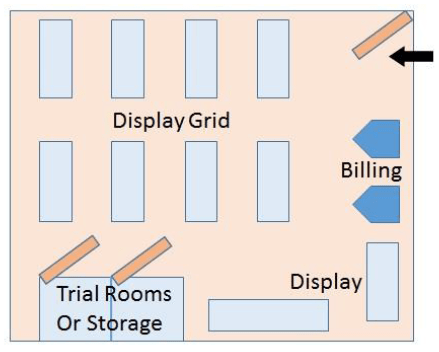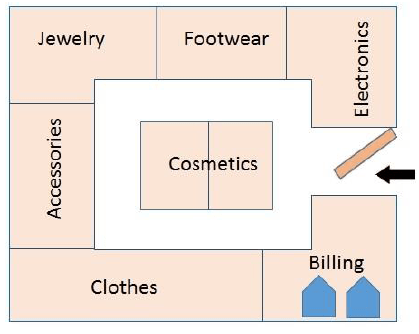Store layouts speak to the design of a store’s retail floor space and merchandising is the display of items, within the store layout, in such a way that shoppers are enticed to purchase. The layout and the merchandising of a store are both critical and connected. In this post, we will be sharing some basics on store layouts and how they are connected to merchandising.
We will also share how you can create efficient retail spaces which attract customers and encourage more purchases.
How store layouts and merchandising mix?
In retail, the speed at which you move merchandise is the name of the game. Moving merchandise effectively is dependent on several things, with the most critical being product placement how and where you place certain items. This is where store layouts and merchandising mix.
Retailers, with the help of space planners, plan out their retail space in such a way that they maximise on floor space yet give customers enough space to easily access merchandise.
Merchandising, which is the display of merchandise in an appealing manner to encourage customers to make purchases, relies on the store layout to have shoppers walk through more than just one section of a store. Smart store layouts also reduct congestion during peak shopping hours. The two are inseparable, and to maximise profit, retailers need to take both into consideration.
Optimal store layouts
To achieve an optimal store layout, there are certain key principles which must be taken into consideration, namely:
When it comes to store layouts, the physical arrangement of items must account for not just the customer who will purchase the item, but also for the “influencer” causing the purchase. For example, parents make a vast majority of purchases with their children in mind, meaning that children are influencing how they shop and what they buy.
A store’s layout and merchandising must take this into consideration and make sure children who accompany parents while shopping, influence them into making purchases ultimately increasing profit.
There are many secrets to successful retailing for retailers, and understanding how to guide customers’ movements through stores is an important one.
Traffic flow, which is the movement of customers through a store, psychologically affects the shopping behaviour of customers. A store’s layout, as well as the merchandising of items in-store, influence not just how customers move through the store, but how they shop too. For example, when grocery shopping, where do you find staples like eggs, bread or milk?
They are often deliberately placed at the back of the store, forcing customers to walk through aisles and past several other items on the way one of the most effective store layout and merchandising strategies in retail.
When it comes to store layouts, the physical arrangement of items must account for not just the customer who will purchase the item, but also for the “influencer” causing the purchase. For example, parents make a vast majority of purchases with their children in mind, meaning that children are influencing how they shop and what they buy.
A store’s layout and merchandising must take this into consideration and make sure children who accompany parents while shopping, influence them into making purchases ultimately increasing profit.
There are many secrets to successful retailing for retailers, and understanding how to guide customers’ movements through stores is an important one.
Traffic flow, which is the movement of customers through a store, psychologically affects the shopping behaviour of customers. A store’s layout, as well as the merchandising of items in-store, influence not just how customers move through the store, but how they shop too. For example, when grocery shopping, where do you find staples like eggs, bread or milk?
They are often deliberately placed at the back of the store, forcing customers to walk through aisles and past several other items on the way one of the most effective store layout and merchandising strategies in retail.
Store layout
It is the process of managing the floor space adequately to facilitate the customers and to increase the sale. Since store space is a limited resource, it needs to be used wisely.
Space management is very crucial in retail as the sales volume and gross profitability depends on the amount of space used to generate those sales.
Optimum Space Use
While allocating the space to various products, the managers need to consider the following points:
(i) Product Category
- Profit builders: High profit margins-low sales products. Allocate quality space rather than quantity.
- Star performers: Products exceeding sales and profit margins. Allocate large amount of quality space.
- Space wasters: Low sales-low profit margins products. Put them at the top or bottom of shelves.
- Traffic builders: High sales-low profit margins products. These products need to be displayed close to impulse products.
(ii) Size, shape, and weight of the product.
(iii) Product adjacencies − It means which products can coexist on display?
(iv) Product life on the shelf.
Retail Floor Space
Here are the steps to take into consideration for using floor space effectively:
- Measure the total area of space available.
- Divide this area into selling and non-selling areas such as aisle, storage, promotional displays, customer support cell, (trial rooms in case of clothing retail) and billing counters.
- Create a Planogram, a pictorial diagram that depicts how and where to place specific retail products on shelves or displays in order to increase customer purchases.
- Allocate the selling space to each product category. Determine the amount of space for a particular category by considering historical and forecasted sales data. Determine the space for billing counter by referring historical customer volume data. In case of clothing retail, allocate a separate space for trial rooms that is near the product display but away from the billing area.
- Determine the location of the product categories within the space. This helps the customers to locate the required product easily.
- Decide product adjacencies logically. This facilitates multiple product purchase. For example, pasta sauces and spices are kept near raw pasta packets.
- Make use of irregular shaped corner space wisely. Some products such as domestic cleaning devices or garden furniture can stand in a corner.
- Allocate space for promotional displays and schemes facing towards road to notify and attract the customers. Use glass walls or doors wisely for promotion.
Store Layout and Design
Customer buying behavior is an important point of consideration while designing store layout. The objectives of store layout and design are −
- It should attract customers.
- It should help the customers to locate the products effortlessly.
- It should help the customers spend longer time in the store.
- It should motivate customers to make unplanned, impulsive purchases.
- It should influence the customers’ buying behavior.
Store Layout Formats
The retail store layouts are designed in way to use the space efficiently. There are broadly three popular layouts for retail stores
Grid Layout: Mainly used in grocery stores.
Loop Layout: Used in malls and departmental stores.
Free Layout: Followed mainly in luxury retail or fashion stores.



Design and Visual Merchandising, Atmospherics
Visual Merchandising
It is the activity of developing floor plans and three-dimensional displays in order to engage customers and boost sales. Both, products or services can be displayed to highlight their features and benefits.
It is based on the idea that good looks pay off. It requires creativity and an eye for presenting the products or services aesthetically so that the customers find it appealing and are motivated towards buying. Visual merchandising involves displaying products or services aesthetically using various objects, colors, shapes, materials, designs, and styles to attract the customers.
One thought on “Retail Operations Stores Layout and Visual Merchandising”